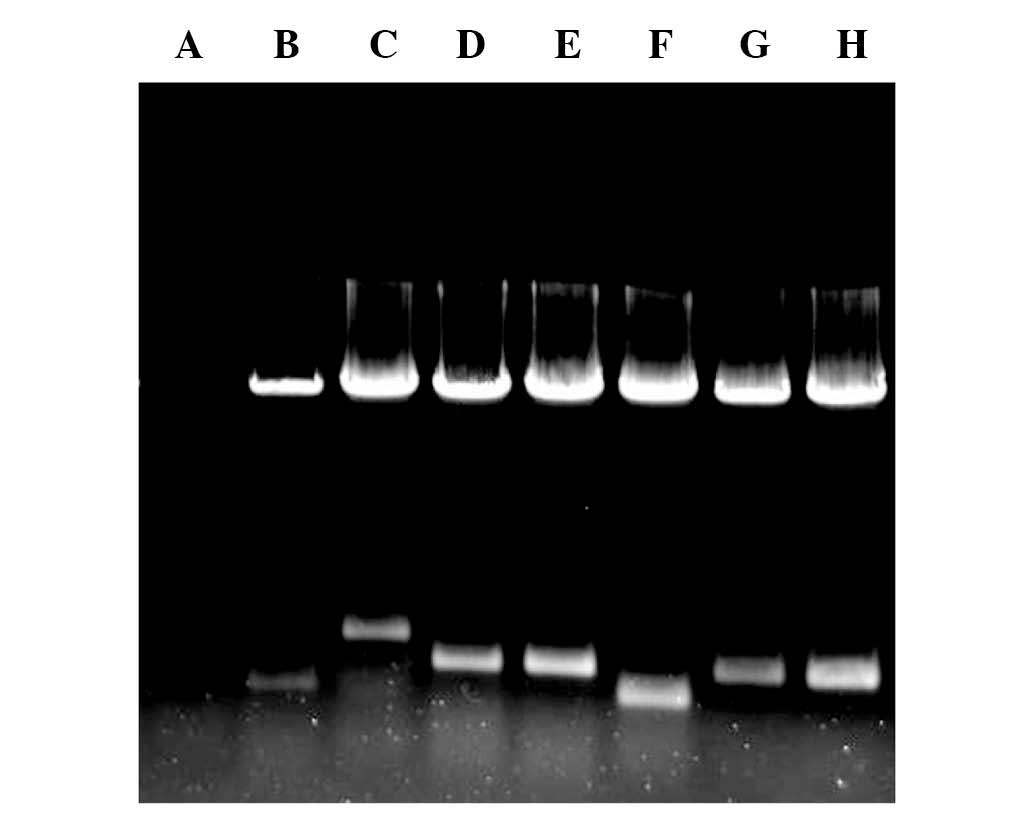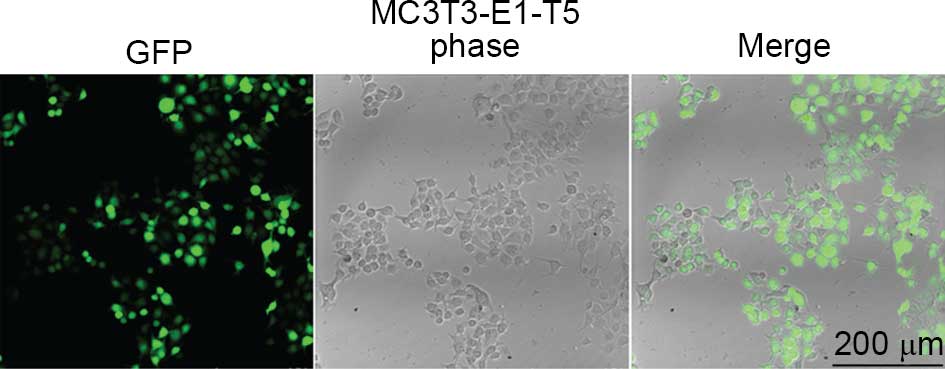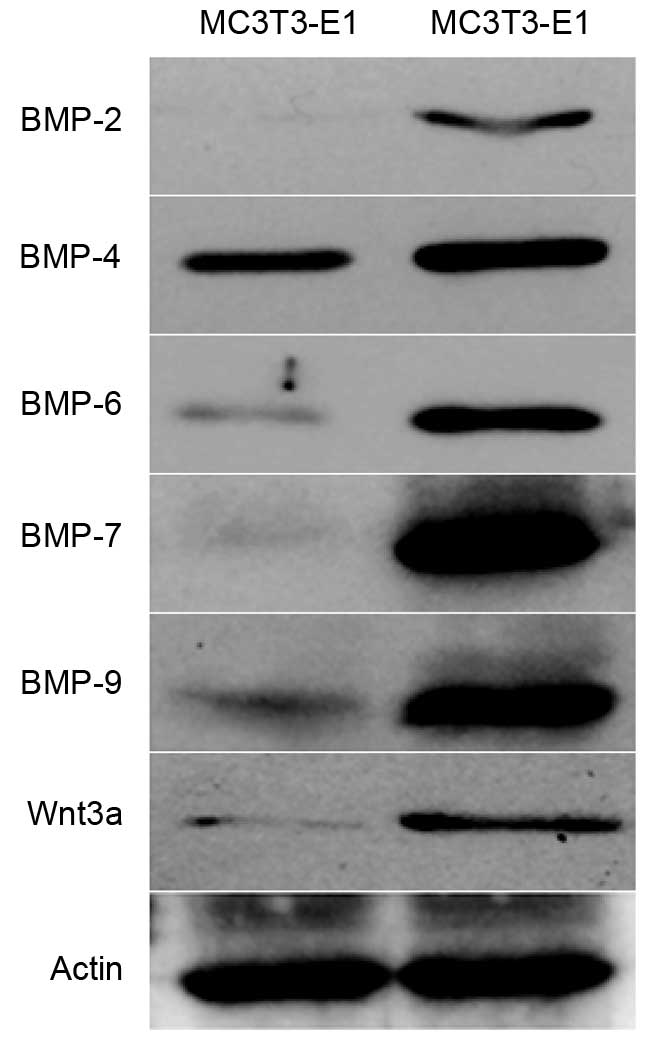|
1
|
Grässel S and Lorenz J: Tissue-engineering
strategies to repair chondral and osteochondral tissue in
osteoarthritis: Use of mesenchymal stem cells. Curr Rheumatol Rep.
16:4522014. View Article : Google Scholar : PubMed/NCBI
|
|
2
|
Ochi M, Nakasa T, Kamei G, Usman MA and
Mahmoud E: Regenerative medicine in orthopedics using cells,
scaffold and microRNA. J Orthop Sci. 19:521–528. 2014. View Article : Google Scholar : PubMed/NCBI
|
|
3
|
Bayrak ES, Mehdizadeh H, Akar B, Somo SI,
Brey EM and Cinar A: Agent-based modeling of osteogenic
differentiation of mesenchymal stem cells in porous biomaterials.
Conf Proc IEEE Eng Med Biol Soc. 2014:2924–2927. 2014.PubMed/NCBI
|
|
4
|
Oryan A, Alidadi S, Moshiri A and Maffulli
N: Bone regenerative medicine: Classic options, novel strategies
and future directions. J Orthop Surg Res. 9:182014. View Article : Google Scholar : PubMed/NCBI
|
|
5
|
Kwon TK, Song JM, Kim IR, Park BS, Kim CH,
Cheong IK and Shin SH: Effect of recombinant human bone
morphogenetic protein-2 on bisphosphonate-treated osteoblasts. J
Korean Assoc Oral Maxillofac Surg. 40:291–296. 2014. View Article : Google Scholar : PubMed/NCBI
|
|
6
|
Yan F, Luo S, Jiao Y, Deng Y, Du X, Huang
R, Wang Q and Chen W: Molecular characterization of the BMP7 gene
and its potential role in shell formation in Pinctada martensii.
Int J Mol Sci. 15:21215–21228. 2014. View Article : Google Scholar : PubMed/NCBI
|
|
7
|
Wang RN, Green J, Wang Z, Deng Y, Qiao M,
Peabody M, Zhang Q, Ye J, Yan Z, Denduluri S, et al: Bone
morphogenetic protein (BMP) signaling in development and human
diseases. Genes Dis. 1:87–105. 2014. View Article : Google Scholar : PubMed/NCBI
|
|
8
|
Wang Y, Li YP, Paulson C, Shao JZ, Zhang
X, Wu M and Chen W: Wnt and the Wnt signaling pathway in bone
development and disease. Front Biosci (Landmark Ed). 19:379–407.
2014. View Article : Google Scholar : PubMed/NCBI
|
|
9
|
Zahoor M, Cha PH, Min do S and Choi KY:
Indirubin-3′-oxime reverses bone loss in ovariectomized and
hindlimb-unloaded mice via activation of the Wnt/β-catenin
signaling. J Bone Miner Res. 29:1196–1205. 2014. View Article : Google Scholar : PubMed/NCBI
|
|
10
|
Heilbronn R and Weger S: Viral vectors for
gene transfer: Current status of gene therapeutics. Handb Exp
Pharmacol. 197:143–170. 2010. View Article : Google Scholar
|
|
11
|
Sugiyama O, An DS, Kung SP, Feeley BT,
Gamradt S, Liu NQ, Chen IS and Lieberman JR: Lentivirus-mediated
gene transfer induces long-term transgene expression of BMP-2 in
vitro and new bone formation in vivo. Mol Ther. 11:390–398. 2005.
View Article : Google Scholar : PubMed/NCBI
|
|
12
|
Benskey MJ and Manfredsson FP: Lentivirus
production and purification. Methods Mol Biol. 1382:107–114. 2016.
View Article : Google Scholar : PubMed/NCBI
|
|
13
|
Livak KJ and Schmittgen TD: Analysis of
relative gene expression data using real-time quantitative PCR and
the 2(−Delta Delta C(T)) Method. Methods. 25:402–408. 2001.
View Article : Google Scholar : PubMed/NCBI
|
|
14
|
Krause C, Korchynskyi O, de Rooij K,
Weidauer SE, de Gorter DJ, van Bezooijen RL, Hatsell S, Economides
AN, Mueller TD, Löwik CW and ten Dijke P: Distinct modes of
inhibition by sclerostin on bone morphogenetic protein and Wnt
signaling pathways. J Biol Chem. 285:41614–41626. 2010. View Article : Google Scholar : PubMed/NCBI
|
|
15
|
Zhou S, Zilberman Y, Wassermann K, Bain
SD, Sadovsky Y and Gazit D: Estrogen modulates estrogen receptor
alpha and beta expression, osteogenic activity, and apoptosis in
mesenchymal stem cells (MSCs) of osteoporotic mice. J Cell Biochem
Suppl. 36:144–155. 2001. View
Article : Google Scholar : PubMed/NCBI
|
|
16
|
Hernigou P, Flouzat-Lachaniette CH,
Delambre J, Poignard A, Allain J, Chevallier N and Rouard H:
Osteonecrosis repair with bone marrow cell therapies: State of the
clinical art. Bone. 70:102–109. 2015. View Article : Google Scholar : PubMed/NCBI
|
|
17
|
Virk MS, Conduah A, Park SH, Liu N,
Sugiyama O, Cuomo A, Kang C and Lieberman JR: Influence of
short-term adenoviral vector and prolonged lentiviral vector
mediated bone morphogenetic protein-2 expression on the quality of
bone repair in a rat femoral defect model. Bone. 42:921–931. 2008.
View Article : Google Scholar : PubMed/NCBI
|
|
18
|
Kotterman MA and Schaffer DV: Engineering
adeno-associated viruses for clinical gene therapy. Nat Rev Genet.
15:445–451. 2014. View
Article : Google Scholar : PubMed/NCBI
|
|
19
|
Deichmann A and Schmidt M: Biosafety
considerations using gamma-retroviral vectors in gene therapy. Curr
Gene Ther. 13:469–477. 2013. View Article : Google Scholar : PubMed/NCBI
|
|
20
|
Maier P, von Kalle C and Laufs S:
Retroviral vectors for gene therapy. Future Microbiol. 5:1507–1523.
2010. View Article : Google Scholar : PubMed/NCBI
|
|
21
|
Pauwels K, Gijsbers R, Toelen J, Schambach
A, Willard-Gallo K, Verheust C, Debyser Z and Herman P:
State-of-the-art lentiviral vectors for research use: Risk
assessment and biosafety recommendations. Curr Gene Ther.
9:459–474. 2009. View Article : Google Scholar : PubMed/NCBI
|
|
22
|
Rothe M, Modlich U and Schambach A:
Biosafety challenges for use of lentiviral vectors in gene therapy.
Curr Gene Ther. 13:453–468. 2013. View Article : Google Scholar : PubMed/NCBI
|
|
23
|
Dull T, Zufferey R, Kelly M, Mandel RJ,
Nguyen M, Trono D and Naldini L: A third-generation lentivirus
vector with a conditional packaging system. J Virol. 72:8463–8471.
1998.PubMed/NCBI
|
|
24
|
Miller F, Hinze U, Chichkov B, Leibold W,
Lenarz T and Paasche G: Validation of eGFP fluorescence intensity
for testing in vitro cytotoxicity according to ISO 10993-5. J
Biomed Mater Res B Appl Biomater. Dec 24–2015.Epub ahead of print.
View Article : Google Scholar
|
|
25
|
Witting SR, Vallanda P and Gamble AL:
Characterization of a third generation lentiviral vector
pseudotyped with Nipah virus envelope proteins for endothelial cell
transduction. Gene Ther. 20:997–1005. 2013. View Article : Google Scholar : PubMed/NCBI
|
|
26
|
Mátrai J, Chuah MK and VandenDriessche T:
Recent advances in lentiviral vector development and applications.
Mol Ther. 18:477–490. 2010. View Article : Google Scholar : PubMed/NCBI
|
|
27
|
Iwasaki S, Hattori A, Sato M, Tsujimoto M
and Kohno M: Characterization of the bone morphogenetic protein-2
as a neurotrophic factor. Induction of neuronal differentiation of
PC12 cells in the absence of mitogen-activated protein kinase
activation. J Biol Chem. 271:17360–17365. 1996. View Article : Google Scholar : PubMed/NCBI
|
|
28
|
Usas A, Ho AM, Cooper GM, Olshanski A,
Peng H and Huard J: Bone regeneration mediated by BMP4-expressing
muscle-derived stem cells is affected by delivery system. Tissue
Eng Part A. 15:285–293. 2009. View Article : Google Scholar : PubMed/NCBI
|
|
29
|
Jeffery TK, Upton PD, Trembath RC and
Morrell NW: BMP4 inhibits proliferation and promotes myocyte
differentiation of lung fibroblasts via Smad1 and JNK pathways. Am
J Physiol Lung Cell Mol Physiol. 288:L370–L378. 2005. View Article : Google Scholar : PubMed/NCBI
|
|
30
|
Gitelman SE, Kirk M, Ye JQ, Filvaroff EH,
Kahn AJ and Derynck R: Vgr-1/BMP-6 induces osteoblastic
differentiation of pluripotential mesenchymal cells. Cell Growth
Differ. 6:827–836. 1995.PubMed/NCBI
|
|
31
|
Desmyter S, Goubau Y, Benahmed N, de Wever
A and Verdonk R: The role of bone morphogenetic protein-7
(Osteogenic Protein-1) in the treatment of tibial fracture
non-unions. An overview of the use in Belgium. Acta Orthop Belg.
74:534–537. 2008.PubMed/NCBI
|
|
32
|
Bibbo C, Nelson J, Ehrlich D and Rougeux
B: Bone morphogenetic proteins: Indications and uses. Clin Podiatr
Med Surg. 32:35–43. 2015. View Article : Google Scholar : PubMed/NCBI
|
|
33
|
Zhou S, Mizuno S and Glowacki J: Wnt
pathway regulation by demineralized bone is approximated by both
BMP-2 and TGF-β1 signaling. J Orthop Res. 31:554–560. 2013.
View Article : Google Scholar : PubMed/NCBI
|
|
34
|
Wagner ER, Zhu G, Zhang BQ, Luo Q, Shi Q,
Huang E, Gao Y, Gao JL, Kim SH, Rastegar F, et al: The therapeutic
potential of the Wnt signaling pathway in bone disorders. Curr Mol
Pharmacol. 4:14–25. 2011. View Article : Google Scholar : PubMed/NCBI
|
|
35
|
Conway JD, Shabtai L, Bauernschub A and
Specht SC: BMP-7 versus BMP-2 for the treatment of long bone
nonunion. Orthopedics. 37:e1049–e1057. 2014. View Article : Google Scholar : PubMed/NCBI
|
|
36
|
Cirano FR, Togashi AY, Marques MM,
Pustiglioni FE and Lima LA: Role of rhBMP-2 and rhBMP-7 in the
metabolism and differentiation of osteoblast-like cells cultured on
chemically modified titanium surfaces. J Oral Implantol.
40:655–659. 2014. View Article : Google Scholar : PubMed/NCBI
|














